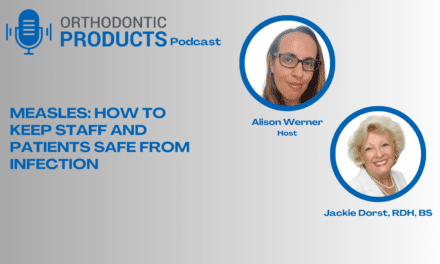Summary: Leon Klempner, DDS, CEO of People + Practice and host of The Golden Age of Orthodontics Podcast, joins the Orthodontic Products Podcast to break down the challenges of measuring marketing ROI in orthodontic practices and shares strategies for improving patient acquisition and retention.
Key Takeaways:
-
Track Comprehensive Metrics: Focus on both quantitative data (eg, inquiries and starts) and qualitative data (eg, lead quality) to get a holistic view of marketing performance.
-
Optimize the Patient Journey: Use the website as the central hub for inquiries and implement trackable links, forms, and tools to convert leads effectively.
-
Allow Time for Results: Recognize that marketing success requires patience, with most campaigns delivering measurable ROI within 9 to 12 months.
In this episode of the Orthodontic Products Podcast, host Alison Werner sits down with Leon Klempner, DDS, CEO of People + Practice, an orthodontic marketing agency, and host of The Golden Age of Orthodontics Podcast. Together, they explore the nuanced topic of measuring return on investment (ROI) in marketing campaigns for orthodontic practices. Klempner shares his expertise on effective strategies, common pitfalls, and actionable insights for maximizing marketing outcomes.
Understanding the Complexity of ROI in Orthodontic Marketing
Klempner begins by emphasizing the complexity of evaluating ROI in orthodontic marketing. He explains that a patient’s decision-making journey is multifaceted, involving multiple touchpoints like digital ads, social media, public reviews, and websites. According to Klempner, practices should focus on using their website as the central hub for all patient inquiries and interactions. He underscores the importance of tracking both quantitative metrics (such as appointment calls, form submissions, and starts) and qualitative insights (such as the quality of leads). Ultimately, the key benchmark for success is an increase in patient starts and production numbers, not necessarily ad impressions.
The Pitfalls of Inaccurate Referral Tracking
One of the significant challenges orthodontic practices face, according to Klempner, is inaccurate or overly simplistic data collection methods. Many practices rely on patient management systems that oversimplify referral tracking or leading in-person questions like “Who can we thank for referring you?”, leading to unreliable information. For example, patients often cite their dentist as the referral source when, in reality, they may have been influenced by online research or social media. This highlights the need for more robust systems to track the complete patient journey accurately.
Setting Realistic Expectations for Marketing ROI
Klempner also discusses the timeline for seeing measurable ROI. He advises orthodontists to give their marketing efforts sufficient time—typically 9 to 12 months—for strategies to mature and deliver results. Marketing is a long-term investment, and practices should manage their expectations accordingly. On average, practices can expect a return of six to ten times their marketing investment, provided they maintain existing referrals and optimize their advertising spend.
Introducing PatientCue: A Tool for Smarter Lead Management
Klempner concludes by introducing PatientCue, a lead dashboard app developed by People + Practice. This tool allows practices to engage with prospective patients through presale communication, addressing barriers like insurance inquiries or scheduling concerns before they become obstacles. By tracking these interactions, practices can gain valuable insights into the effectiveness of their marketing campaigns. OP
Podcast Transcript
Alison Werner (00:05)
Hello and welcome to the orthodontic products podcast. I’m your host, Alison Werner. In this episode, we’re going to talk about how to measure the return on investment or ROI when it comes to your marketing campaigns. And joining me to do this is Dr. Leon Klempner, co-founder of People and Practice an orthodontic marketing agency and host of the Golden Age of Orthodontics podcast. Dr. Klempner, thanks for joining me again.
Dr. Leon Klempner (00:25)
thanks for having me. My pleasure.
Alison Werner (00:26)
Yeah, okay, so let’s get started. What kind of metrics do you suggest every orthodontic practice have in place to measure to to measure to determine ROI?
Dr. Leon Klempner (00:37)
I’m so glad you asked that question, Alison, because as orthodontists, you know that we’re very data-driven. So I’m going to answer that question, but I want to provide a little context first. So as a marketing agency, this is an essential discussion that we have with every one of our clients at the beginning, because there’s a lot of misinformation out there. Highly effective marketing programs are much more complicated to measure because they mirror the patient’s
decision-making journey, which is multifaceted and has multiple touch points. So hear me, orthodontists, when I tell you it’s a fallacy to believe that there’s a linear relationship that exists between any given marketing campaign and the number of high-quality calls or form fills that you’ll get on the website.
So we don’t measure how many leads one singular ad or one social media post would get because it doesn’t make any sense. Rather, we use the website as a central point to drive all patient inquiries. So we’ll use digital advertising, Google, Facebook, Instagram, social media, public reviews, which all work together not only to raise awareness, but also to educate and drive relevant new patient inquiries to the website so they
can learn more and call for an appointment. So to answer your question directly now, we do need data to measure results. So there are two areas of measurements that well orthodontists really should take into account when measuring their ROI. And they’re equally as important. One is quantitative, right? This is
the basic ones, like how many appointment inquiry calls, how many form fills on the website, how many consultations being seen, how many starts. These are all things that clearly should be measured, but there’s also a qualitative area that should be addressed as well, the quality of the leads. So I mentioned earlier that at People and Practice, we understand the patient, new patient journey by mirroring our marketing to reflect
how we can create a stronger new patient inquiry that’s more likely to convert. So the bottom line is that the number of people who say yes to starting should be the gauge that should determine whether your marketing is working. So your production should go up. That’s the most important thing, the starts. That’s what orthodontists want.
Alison Werner (03:11)
Yeah.
Dr. Leon Klempner (03:12)
So sure, we look at all the different metrics, we look at all of the impressions. As an orthodontist, that doesn’t mean much to me. What’s important to me is how many new starts am I getting in my production numbers going up? Make sense?
Alison Werner (03:17)
Mm-hmm.
Right.
Yeah, that’s a way to keep it simpler and not get caught up in just the noise. Yeah. Okay. So what are some of the pitfalls you see practices run into when they do measure ROI of their marketing efforts? When they try to measure the ROI of their marketing efforts?
Dr. Leon Klempner (03:33)
Mm-hmm.
Yeah, you
know, I see most practices, like I once did when I was in practice, look at, you know, the new patient front intake calls for the answers to what’s working and what’s not. And you know that adage garbage in, garbage out? Well, most
unfortunately, most orthodontic patient management systems have form fields that are very, very simple and not really that reliable. So typically, you know, the, your front desk personnel has to put in just one answer. Is it a dentist? Is it a patient or is it other? So, you know, when, when, presented that way, patients, you know, think that saying that they were referred by their dentist is more credible,
so they say dentist. Now, you know, for those orthodontists listening, you know as well as I know, when we see a patient coming from a dentist that never referred to us, some of them that may not even like us, then we know that that’s not a credible thing. So that’s one area. The other is when we ask a new patient,
Alison Werner (04:35)
Mm.
Right.
Dr. Leon Klempner (04:57)
you know, who can we thank for referring you? That’s another kind of leading question that they often will just put their dentist there, even though it has no reality to it. Some will, you know, will say Google, but what does that mean? Is it Google? Is it the SEO? Is it the website? Is it your reviews? Is it your Google business profile? Is it your Google ads that are running? And nobody wants to say Facebook or Instagram, but…
Alison Werner (05:06)
Okay.
Mm-hmm.
Right?
Yeah.
Dr. Leon Klempner (05:27)
You know, in all likelihood, they did see you there. So, you know, the bottom line is it’s usually a combination of all of these different efforts. No matter what patients say, even if the dentist originally actually did refer them, they’ll go online and do their homework anyway.
Alison Werner (05:29)
Mm-hmm.
Alright.
very true. nobody makes a decision in isolation anymore. So how long before an orthodontic practice can measure that return on investment on their marketing?
Dr. Leon Klempner (05:56)
Well, you know, I don’t want to be elusive, but it is variable. You know, it depends on the demographics and it depends on the competition. And, you know, remember that marketing is about repetition.
In our experience, realistically, it takes about 9 to 12 months for an effective marketing machine to really mature. So, orthodontists, give your marketing companies an opportunity. Don’t expect just because you hired them a month later that you’re going to see this huge bump. It doesn’t work that way. It takes time to put these elements into place, but in the long run, you’ll see the returns.
Alison Werner (06:27)
Yeah.
Okay, so is there a specific expectation orthodontic practices should have with regard to the return on investment?
Dr. Leon Klempner (06:43)
Yeah, yeah, that’s the good news about this whole thing. At People and Practice, we see that on average for every dollar invested, you should expect between 6 and 10x of that amount in return. So for example,
Alison Werner (06:56)
Okay.
Dr. Leon Klempner (07:00)
for every dollar invested, there should be a commensurate increase in your production. So practice, let’s say that’s investing $3,000 a month in marketing. So that’s $36,000 a year. So they should see a production bump of about $200,000 or more in yearly production. Now, having said that, so before I get all the phone calls.
Alison Werner (07:12)
Mm-hmm.
Okay.
Dr. Leon Klempner (07:24)
There’s some qualifiers here, right?
It depends on the market that you’re in. It depends on the competition. It also depends on your ability to maintain your current dental referrals and of course your ad spend. So a sweet spot needs to be determined and we use analytics to help our clients to find that.
Alison Werner (07:46)
Okay, so to do this, what type of systems or protocols need to be in place in the practice?
Dr. Leon Klempner (07:54)
Well, like I mentioned earlier, new patient decision makers first do their online research via a variety of multiple touch points. Then they call and contact your office on your website. So luckily, connecting their devices to your system is getting easier in this digital age. So your website is a touch point that you have a lot of control over. To me,
the sole reason of having a website at all is to drive new consults. So if you funnel people through the website via trackable links, forms, chatbots, phone numbers, then we could track campaigns from first touch to patient starts.
And although we track all metrics from Google, Facebook, Instagram, more importantly, we measure the final touch points. People who either call you or submit consult request forms that are influenced by our marketing in one way or another before they reach out. It’s really critical to warm them up.
so it’s easier to convert. This is where brand awareness and most importantly educating them about your differentiator plays such an important role. And if you recall, I think we talked about this in a previous episode, it’s important for practices to have differentiators.
Alison Werner (09:25)
Right.
Dr. Leon Klempner (09:25)
You know, that’s critical. And if you envision a Venn diagram of three circles, one circle being what you do really well, another circle being what the new patients want, and the third circle being what your competition is not advertising, the center of that Venn diagram, that’s your differentiator. And you need to hammer that home on all of your online efforts. My partner Amy, partner daughter Amy,
Amy is really an expert in that field. And notably, practices need to communicate with new patient inquiries before they commit to a consult. So if you allow me some shameless self-promotion, at People and Practice, we developed some new lead software, a new lead dashboard app called PatientCue
Alison Werner (10:08)
Hmm.
Dr. Leon Klempner (10:19)
which allows patients to reach out to the practice on the website by chat or web form. And the practice can communicate and respond to their inquiries by text. This is before they become a patient, before your practice management system can connect with them via text. So you could do this on your desktop. You can do this on your mobile device. But essentially is a pre-sale.
Alison Werner (10:29)
Mm.
okay.
Dr. Leon Klempner (10:44)
tool designed to give new patients as much information as quickly as possible. A lot of times they just want to know one thing before they make that appointment and they won’t do it. Do you take my insurance? You open on Saturday? Who knows what the stumbling block is, but if we can address that and overcome that, then they’ll move along. And then from there, from that dashboard, we can actually track those inquiries.
Alison Werner (10:53)
Yeah.
Right.
Dr. Leon Klempner (11:11)
from the website, report on the percentage influenced by the strength of our marketing activities.
Alison Werner (11:18)
Okay. Well, that sounds like a piece of information that also needs to be tracked to really know that you are getting that return on investment. So Dr. Klempner, thank you so much for your insight. And again, if people want to get in touch with you, they can find you guys at peopleandpractice.com. Am I getting that right? Okay.
Dr. Leon Klempner (11:25)
Absolutely.
Yep,
pplpractice.com, pplpractice.com or leon at pplpractice.com. Thank you, Alison. I appreciate it. Bye.
Alison Werner (11:39)
Okay, people, y’all done.
Excellent. thank you so much. All right, take care.













